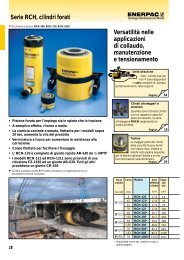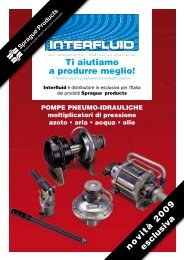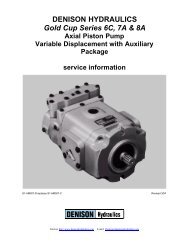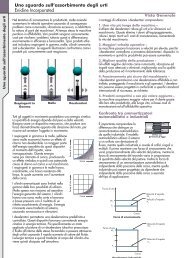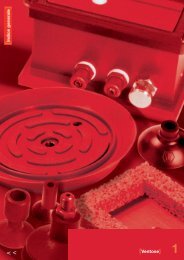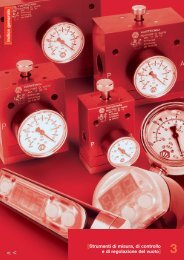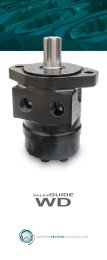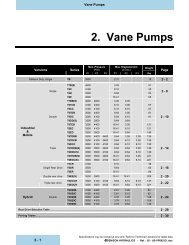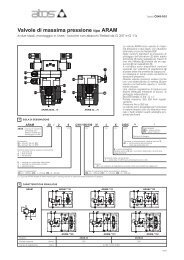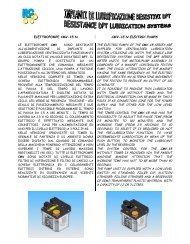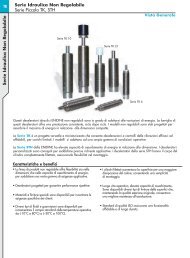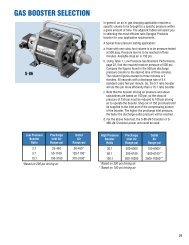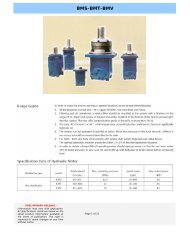Denison PV series - Interfluid S.r.l..
Denison PV series - Interfluid S.r.l..
Denison PV series - Interfluid S.r.l..
Create successful ePaper yourself
Turn your PDF publications into a flip-book with our unique Google optimized e-Paper software.
DESCRIPTION<br />
SERVICE INFORMATION<br />
These hydraulic products are designed to give long dependable service when properly<br />
applied and their systems properly maintained. These general instructions apply to typical<br />
systems. Specific instructions for particular equipment can be developed from<br />
them.<br />
Refer to bulletin S1-AM009 for service information.<br />
RECOMMENDED FLUIDS<br />
The fluid recommended for use in these pumps has a petroleum base and contains<br />
agents which provide oxidation inhibition and anti-rust, anti-foam and de-aerating properties<br />
as described in DENISON HYDRAULICS standard HF-1. Where anti-wear additive<br />
fluids are specified, see DENISON HYDRAULICS standard HF-0.<br />
VISCOSITY<br />
VISCOSITY INDEX<br />
max. at cold start- 7500 SUS (1600 cSt)<br />
at low pressure, low flow, and if possible, low speed<br />
max. at full power- 750 SUS (160 cSt)<br />
optimum for max. life- 140 SUS (30 cSt)<br />
minimum at full power- 60 SUS (10 cSt)<br />
90 V. I. minimum. Higher values extend the range of operating temperature but may<br />
reduce the service life of the fluid.<br />
TEMPERATURE<br />
Determined by the viscosity characteristics of the fluid used. Because high temperatures<br />
degrade seals, reduce the service life of the fluid and create hazards, fluid temperature<br />
should not exceed 180°F (82°C) at the case drain.<br />
MAINTENANCE<br />
The pump is self-lubricating and preventative maintenance is limited to keeping system<br />
fluid clean by changing filters frequently. Keep all fittings and screws tight. Do not<br />
operate at pressures and speeds in excess of the recommended limit. If the pump<br />
does not operate properly, check the troubleshooting chart before attempting to overhaul<br />
the unit. Overhauling may be accomplished by referring to the disassembly,<br />
rework limits of wear parts, and assembly procedures. Refer to the service manual for<br />
troubleshooting and overhaul information.<br />
FLUID CLEANLINESS<br />
Fluid must be cleaned before and continuously during operation by filters that maintain<br />
a cleanliness level of ISO 17/14. This approximately corresponds to NAS 1638 class 8<br />
(class 9 for 15 micron and smaller). This fluid level cleanliness can usually be accomplished<br />
by the effective use of 10 micron filters. Better cleanliness levels will significantly<br />
extend the life of the components. As contaminant generation may vary with<br />
each application, each must be analyzed to determine proper filtration to maintain the<br />
required cleanliness level.<br />
COMPARISON OF SOLID CONTAMINATION CLASSIFICATION SYSTEM<br />
NATIONAL AERONAUTICS STANDARD (NAS) 1638<br />
class<br />
00 0 1 2 3 4 5 6 7 8 9 10 11 12<br />
5-15mm 125 250 500 1000 2000 4000 8000 16000 32000 64000 128000 256000 512000 1024000<br />
particle 15-25mm 22 44 89 178 356 712 1425 2850 5700 11400 22800 45600 91200 182400<br />
size 25-50mm 4 8 16 32 63 126 253 506 1012 2025 4050 8100 16200 32400<br />
range 50-100mm 1 2 3 6 11 22 45 90 180 360 720 1440 2880 5760<br />
>100mm 0 0 1 1 2 4 8 16 32 64 128 256 512 1024<br />
maximum >5mm 152 304 609 1217 2432 4864 9731 19462 38924 77849 155698 311396 622792 1245584<br />
particles >15mm 27 54 109 217 432 864 1731 3462 6924 13849 27698 55396 110792 221584<br />
ISO:DIS 4406; SAE J1165<br />
iso solid contaminant code<br />
8/5 9/6 10/7 11/8 12/9 13/10 14/11 15/12 16/13 17/14 18/15 19/16 20/17 21/18 22/19<br />
maximum >5mm 250 500 1000 2000 4000 8000 16000 32000 64000 130000 250000 500000 1000000 2000000 4000000<br />
particles >15mm 32 64 130 250 500 1000 2000 4000 8000 16000 32000 64000 130000 250000 500000<br />
NOTES: All measurements are for a 100 ml sample size.<br />
8



